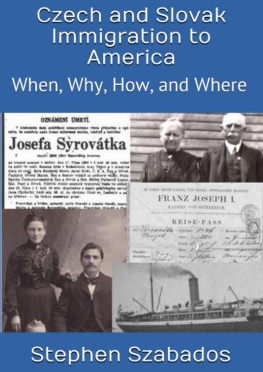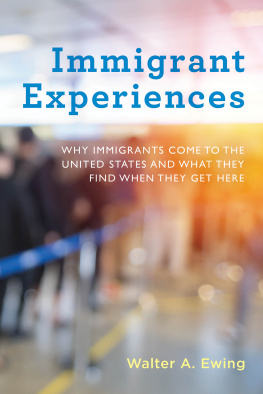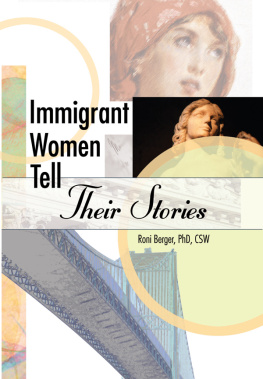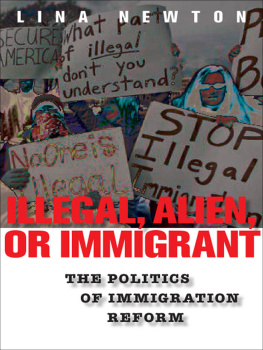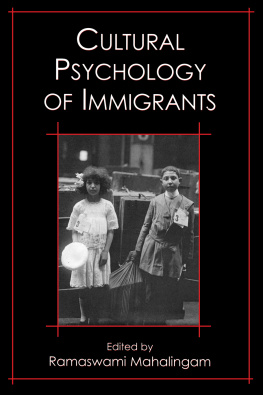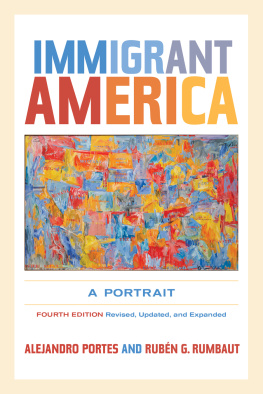Interdisciplinary Perspectives on the New Immigration
Volume 4
The New Immigrant and the American Family
Series Content
Volume 1
THEORETICAL PERSPECTIVES
Volume 2
THE NEW IMMIGRANT IN THE AMERICAN ECONOMY
Volume 3
THE NEW IMMIGRANT IN AMERICAN SOCIETY
Volume 4
THE NEW IMMIGRANT AND THE AMERICAN FAMILY
Volume 5
THE NEW IMMIGRANT AND AMERICAN SCHOOLS
Volume 6
THE NEW IMMIGRANT AND LANGUAGE
Interdisciplinary Perspectives on the New Immigration
Volume 4
The New immigrant and the American Family
Edited with introductions by
Marcelo M. Surez-Orozco
Carola Surez-Orozco
Desire Qin-Hilliard
all Harvard University
Published in 2001 by
Routledge
270 Madison Avenue,
New York, NY 10016
Published in Great Britain by
Routledge
2 Park Square, Milton Park,
Abingdon, Oxon OX14 4RN
Routledge is an imprint of the Taylor & Francis Book, Inc.
Copyright 2001 by Routledge
Transferred to digital printing 2010.
All rights reserved. No part of this book may be reprinted or reproduced or utilized in any form or by any electronic, mechanical, or other means, now known or hereafter invented, including any photocopying and recording, or in any information storage or retrieval system, without permission in writing from the publishers.
10 9 8 7 6 5 4 3 2 1
Library of Congress Cataloging-in-Publication Data
Interdisciplinary perspectives on the new immigration / edited with introductions by Marcelo M. Surez-Orozco, Carola Surez-Orozco, Desire Qin-Hilliard.
p. cm.
Contents: v. 1. Theoretical perspectives -- v. 2. The new immigrant in the American economy -- v. 3. The new immigrant in American society -- v. 4. The new immigrant and the American family -- v. 5. The new immigrant and American schools -- v. 6. The new immigrant and language.
1. Immigrants--United States. 2. United States--Emigration and immigration. I. Surez-Orozco, Marcelo M., 1956- II. Surez-Orozco, Carola, 1957- III. Qin-Hilliard, Desire.
JV6465 .148 2001
304.873--dc21
2001048449
ISBN 978-0-415-88625-3 (POD set)
ISBN 978-0-815-33704-1 (set)
ISBN 978-0-815-33705-8 (v. 1)
ISBN 978-0-815-33706-5 (v. 2)
ISBN 978-0-815-33707-2 (v. 3)
ISBN 978-0-815-33708-9 (v. 4)
ISBN 978-0-815-33709-6 (v. 5)
ISBN 978-0-815-33710-2 (v. 6)
Contents
Carola Surez Orozco
Carlos Sluzki
Judith T. Shuval
Julie F. Smart and David Smart
Cynthia Garca Coll and Katherine Magnuson
Nancy Foner
Mary Waters
Min Zhou and Carl L. Bankston III
Morrison G. Wong
Pyong Gap Min
David Alvirez and Frank Bean
Walter Pierce and Erlange Elisme
Pierrette Hondagneu-Satelo
Abel Valenzuela Jr.
At the turn of the millennium the United States has the largest number of immigrants in its history. As a consequence, immigration has emerged once again as a subject of scholarly inquiry and in policy debates. This series brings together the dominant conceptual and theoretical work on the new immigration. Immigration today is a global and transnational phenomenon that affects every region of the world with unprecedented force. Although this series is devoted to scholarly work on the new immigration specifically in the United States, many of the broader conceptual issues covered here also apply to other postindustrial countries, such as France, Germany, and Japan.
In the United States immigration is both history and destiny. The current wave of immigration has many similarities to the large-scale transoceanic immigration at the turn of the twentieth century, and yet several features distinguish it as unique to the present era.
Up to 1965 immigration to the United States was overwhelmingly a European phenomenon, with countries such as Germany, the United Kingdom, and Ireland leading the way. Todays immigrants are a highly diverse population, originating in such varied settings as Latin America, Asia, and the Caribbean. Majorities of new immigrants who are phenotypically not white are subject to a process of racialization that transforms them in this new context from immigrant outsiders to people of color. In the aftermath of the great struggles of the civil rights movement, race, color, and ethnicity continue to be essential to the social processes that shape the opportunities and life experiences of these new arrivals.
In earlier eras immigration was structured in time-delineated discrete and bounded waves. There was a clear beginning and end date to the various European migrations to the United States. The current pattern of immigration to the United States that had begun to intensify in 1965 and then gained extraordinary momentum in the 1980s and 1990s can best be described as an ongoing flow that ever replenishes the immigrant stock of the nation. This flow seems to be the result of several distinct factors. First, the postindustrial economy has developed a voracious need for immigrant workers. Also, with the passage of the Hart-Cellar Immigration Act in 1965, family reunification became a powerful force that generated and strengthened immigrant chains, as those left behind were given the opportunity to join relatives and loved ones living in the United States. A host of social forces the ease of mass transportation, instant access to information about job opportunities, and the dream for a better standard of living have made migration an increasingly attractive option for many. Finally, armed conflicts, ethnic and religious tensions, and political repression are implicated significantly in population displacements; witness the million-plus Southeast Asians and million-plus Central Americans now living in the United States.
Globalization is yet another basic characteristic that separates the new immigration from the old. Earlier waves of immigration took place in the context of nation-building efforts in which immigrant workers, consumers, and would-be citizens played a significant role. Today, immigration is at the heart of globalization. The three main pillars of globalization are post-national financial markets and the emergence of knowledge-intensive economies; new information and communication technologies that instantaneously connect people across vast spaces; and large-scale immigration. These three phenomena, though discrete, are intertwined. The globalization of capital and the increasingly internationalized production of goods and services are predicated on new communication technologies as well as on capitals ability to mobilize human labor with stunning speed and force. For example, in the 1980s and 1990s Mexicos northern border experienced extraordinary population growth as international interests invested massively in maquiladora assembly plants to take advantage of cheap labor and de-regularized production practices.
This series examines the new immigration from an interdisciplinary and comparative perspective. We bring together the leading minds in the study of immigration from such disparate disciplines as anthropology, economics, demography, psychology, and sociology. We include scholarly work on the impact of the new immigration on the U.S. economy. We also examine at length the ways in which the new immigrants are transforming U.S. society. We present a broad range of scholarship on how immigration affects the family system, as well as the educational opportunities and challenges facing the children of todays immigrants. Finally, we examine the ever-controversial topic of bilingualism and linguistic practices among new immigrants.



